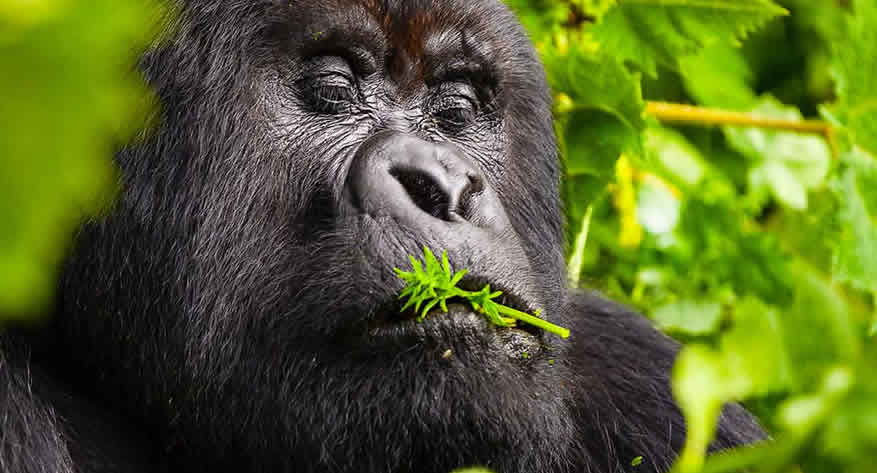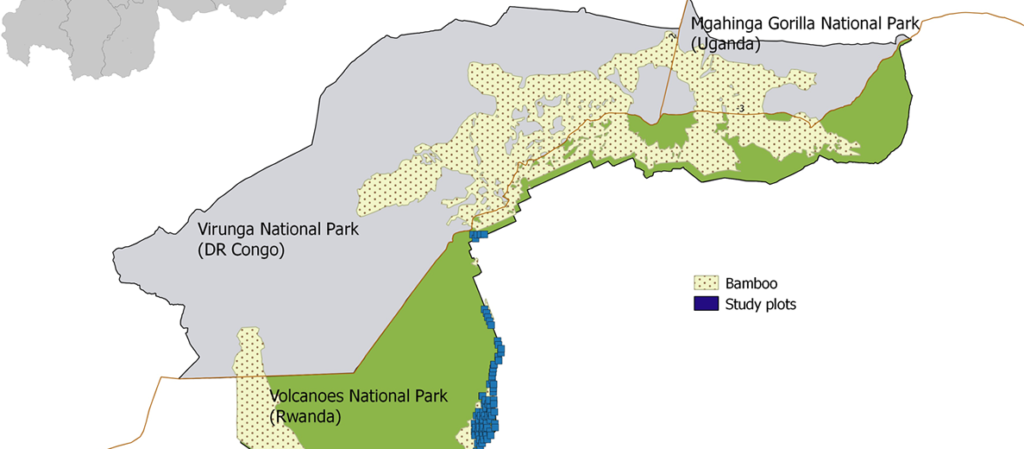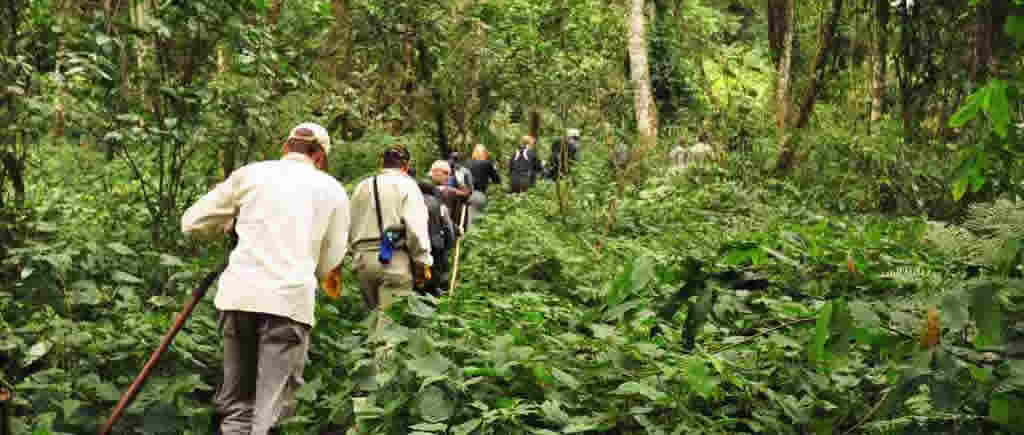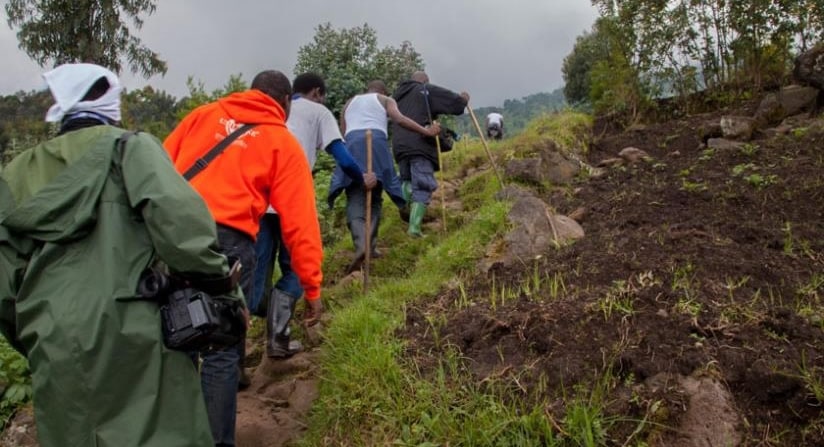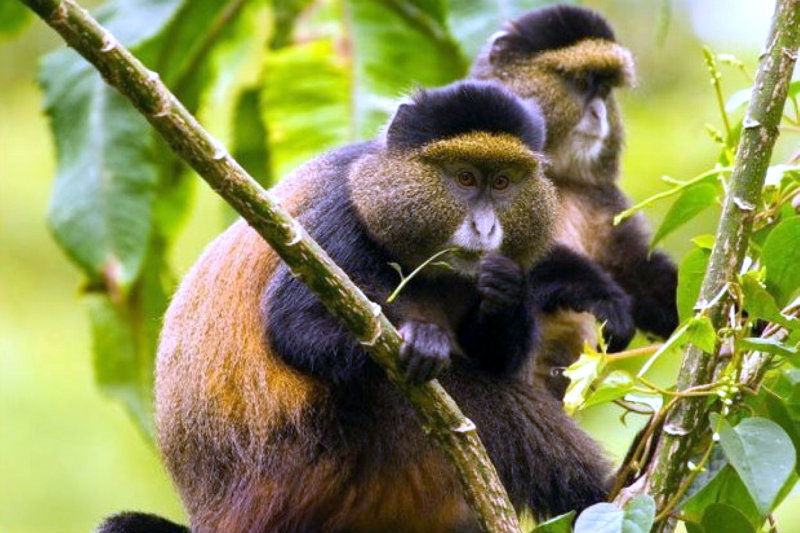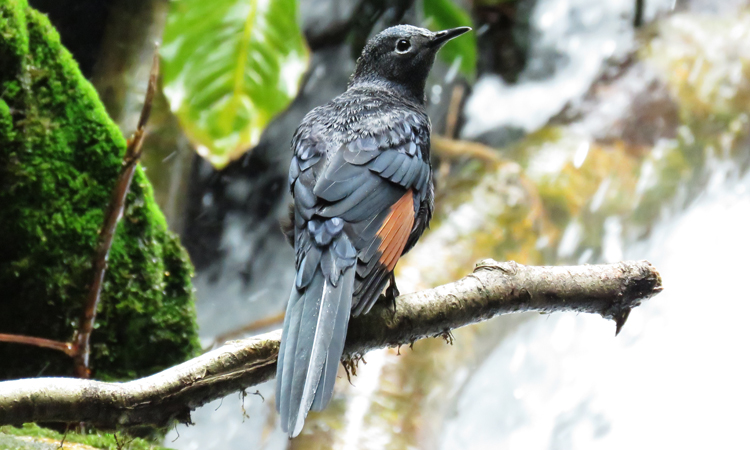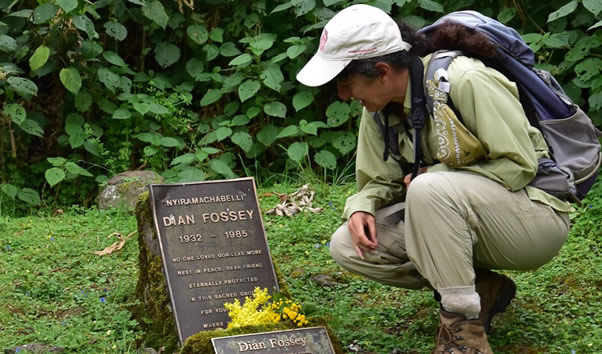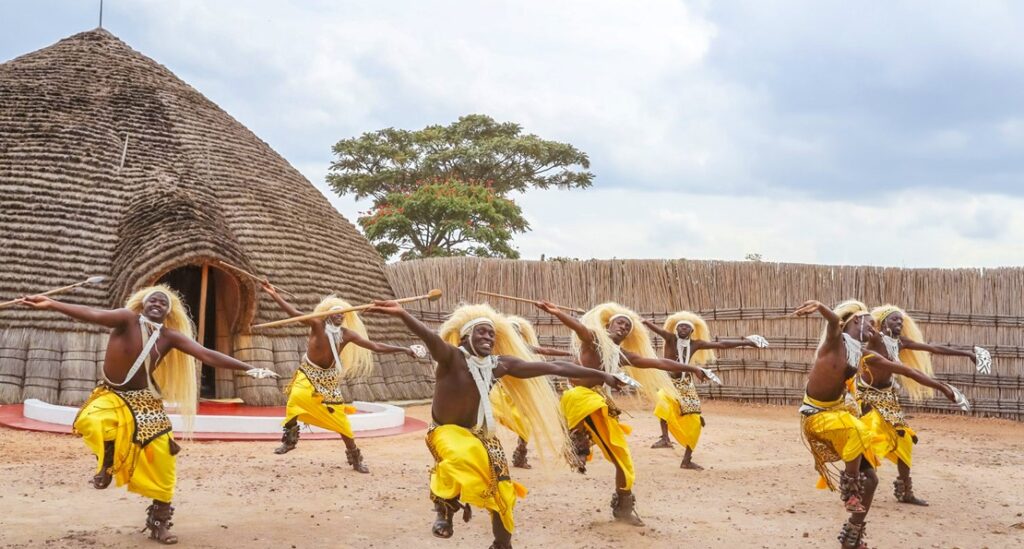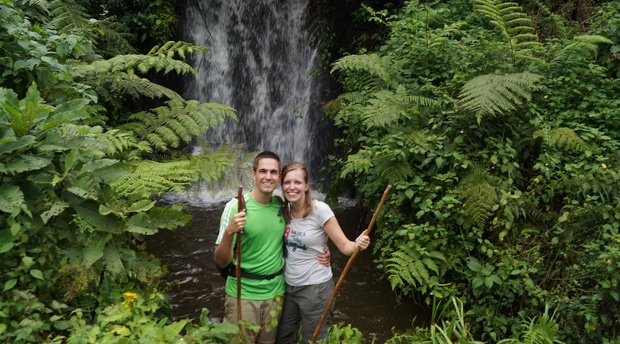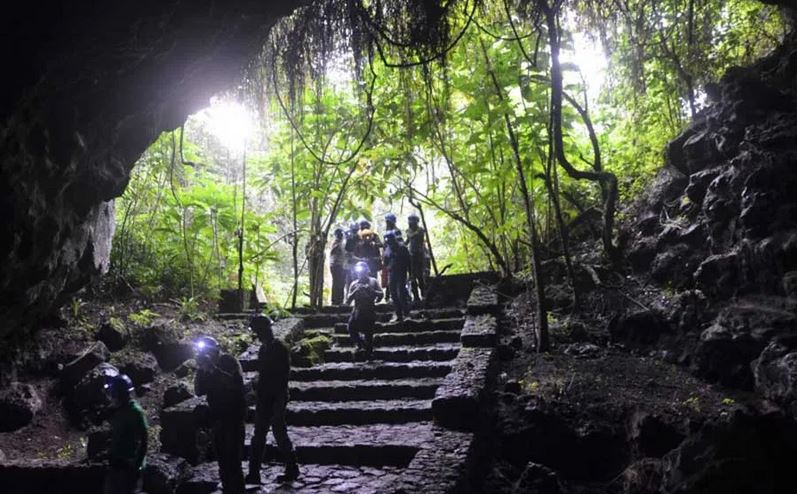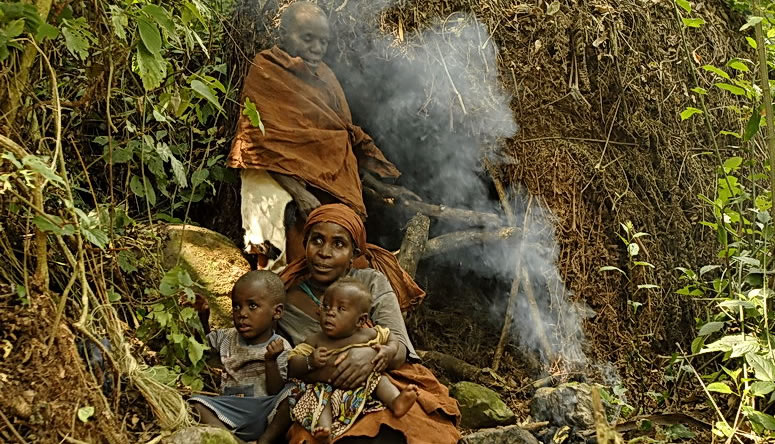Volcanoes national park (VNP) was established in 1925 and is one of the oldest protected areas in Africa. The park is located in the Musanze district of Northern Province 103 km (2-hour drive) north of Kigali’s capital city. VNP forms part of the Virunga massif and extends for 160 sq. km (62 sq.Miles) with 3 of the 8 Virunga volcanoes including Mount Karisimbi (4,507m), Mount Bisoke (3,711m) and Mount Sabinyo 3,634m. The Virunga mountains stretch for 80 sq. km (50 sq.Miles) and straddle the borders of Rwanda, Uganda, and DR Congo, creating the transboundary Virunga Conservation Area (VCA), which is home to 603 of the 1,063 world mountain gorilla population. Volcanoes national park is home to over 200 gorillas of which 12 families have been habituated for tourism since 1967 when Dian Fossey founded Karisoke Research Center with the purpose to prevent poaching and conserving gorillas in the Virunga area. Rwanda gorilla safaris thrive on her legacy and focus mostly on conservation. While you come for a gorilla trek, you should take time to walk in the footsteps of Fossey either through the Dian Fossey Tomb hike or visit the new Ellen DeGeneres Campus of the Dian Fossey Gorilla Fund. This will give you a chance to learn about the history and future of mountain gorilla research and conservation in Rwanda.
Vegetation
Due to the altitude variation from 1,800 m to 4,507 m, , Volcanoes National Park contains 3 vegetation zones including montane forest, bamboo, and afro-alpine. Farmlands for potatoes, coffee, and tea among other crops, and eucalyptus trees can be found in the villages that surround the park. Hiking trails from Kinigi to the park headquarters go through these cultivated fields to the park boundary, which is marked by pink ball (Dombeya) trees that continue to vanish. The montane forest zone and an extensive bamboo zone, which covers almost 30% of the park, start at 2,000m and stretch up to 2,600m. Given that both vegetation intertwin together, the forest ranges from dense, moderate to less dense, and open forest, making it easier to hike through. This zone is a habitat for golden monkeys, which can be tracked. There are also forest buffaloes and elephants but it is difficult to see them due to the nature of the terrain. From there, the subalpine zone (2,600m – 3,300m) contains hagenia hypericum forests mostly on the slopes of the Karisimbi volcano. You will see the trees covered by mosses and lichens. Finally, the afro-alpine zone dominates the higher elevations of the volcanoes above 4,000m. This zone contains rare plant species such as giant lobelias and senecios and on the hike to the top of Mount Bisoke, visitors will discover a beautiful crater lake.
Fauna
Volcanoes national park is famous for harboring over 300 mountain gorillas, golden monkeys, and over 178 species of birds of which 17 are Albertine Rift Endemics. Besides, the protected area is also home to mammal species such as forest elephants and buffaloes but these are hard to see due to the nature of the terrain.
Volcanoes national park activities
Gorilla trekking
 Volcanoes National Park’s less dense forests make it easier to hike through in search of gorillas. When compared to a trek through Bwindi, trekking in Rwanda can be less strenuous but requires physical fitness due to the nature of the terrain. For instance, going uphill is always challenging depending on the location of the gorillas, but walking downhill after viewing gorillas is always simpler. Rwanda puts much emphasis on conservation with a high-end low impact strategy. This is the reason why the gorilla permit, which is available for booking through RDB or a tour operator, was increased from $750 to $1,500 per person. As gorilla tourism continues to develop, there are several initiatives supporting the adjacent communities including the Gorilla Guardian’s Center (Iby’iwacu cultural village). Gorilla trekking safaris, therefore, go hand in hand with local community tours. Besides, some of the lodges offer responsible experiences including tree planting and Rwandan traditional dance performances that support locals while conserving the ecosystem. Be sure to visit Rwanda gorillas in a responsible manner from choosing a tour company, lodging, and activities.
Volcanoes National Park’s less dense forests make it easier to hike through in search of gorillas. When compared to a trek through Bwindi, trekking in Rwanda can be less strenuous but requires physical fitness due to the nature of the terrain. For instance, going uphill is always challenging depending on the location of the gorillas, but walking downhill after viewing gorillas is always simpler. Rwanda puts much emphasis on conservation with a high-end low impact strategy. This is the reason why the gorilla permit, which is available for booking through RDB or a tour operator, was increased from $750 to $1,500 per person. As gorilla tourism continues to develop, there are several initiatives supporting the adjacent communities including the Gorilla Guardian’s Center (Iby’iwacu cultural village). Gorilla trekking safaris, therefore, go hand in hand with local community tours. Besides, some of the lodges offer responsible experiences including tree planting and Rwandan traditional dance performances that support locals while conserving the ecosystem. Be sure to visit Rwanda gorillas in a responsible manner from choosing a tour company, lodging, and activities.
Now one of the biggest gorilla conservation projects is the expansion of Volcanoes national park. Given that Rwanda’s gorilla population has recently increased from 200 to 300 as indicated by the gorilla naming ceremony records. The increasing gorilla numbers put pressure on the habitat, whose size doesn’t expand accordingly. They thus begin to maraud among the nearby local communities. For that reason, the park is set to be expanded by 23% adding more land equivalent to 37.4 sq. km (3,740 hectares). In addition to the gorillas, Rwanda’s conservation efforts have made progress in recovering wildlife and ecosystems, including the restoration of the Big 5 in Akagera and the opening of new golden monkey tracking in Gishwati Mukura national park – a reminder to go green on your next Rwanda gorilla safari.
Bird watching
 Birding is one of the best reasons to go to Volcanoes national park, a well-known birding destination in Rwanda. Nearly 200 different bird species can be found in the park of which 17 are Albertine Rift Endemics including handsome francolin, red-faced woodland and Grauer’s swamp warbler, strange weaver and Archer’s robin chat. This group also consists of 5 Rwenzori Mountain Range Endemics including Rwenzori Apalis, Batis, turaco, nightjar and double-collared sunbird. Birding excursions are available for half or full days depending on the time you intend to spend in the park.
Birding is one of the best reasons to go to Volcanoes national park, a well-known birding destination in Rwanda. Nearly 200 different bird species can be found in the park of which 17 are Albertine Rift Endemics including handsome francolin, red-faced woodland and Grauer’s swamp warbler, strange weaver and Archer’s robin chat. This group also consists of 5 Rwenzori Mountain Range Endemics including Rwenzori Apalis, Batis, turaco, nightjar and double-collared sunbird. Birding excursions are available for half or full days depending on the time you intend to spend in the park.
Volcano hiking
Hikers in Volcanoes national park can climb Mount Bisoke and the Dian Fossey Tomb hike, which are day-long excursions. For those looking for a multiday hike, a two-day hike with a volcano camping experience is available on Mount Karisimbi. Hikers need to bring drinking water, a hat, sunscreen, and rain gear. Be ready for occasionally hot, damp, or rainy weather and hiking can be challenging due to the nature of the terrain.
Bisoke volcano
Mount Bisoke has an elevation of 3,711m and is the 3rd tallest volcano in the Virunga Massif. It is the most popular and easiest to hike in Volcanoes national park. It can be finished in a day given that it only takes 6 hours to ascend to the summit and 2 hours to descend. Along the trail, hikers will pass through untouched afro-alpine vegetation including moss-covered erica and epiphytic orchids in the montane forest zone. On the Bisoke climb, encounters with golden monkeys are frequent but not guaranteed. There is a small crater-filled lake on Bisoke’s summit, and a pathway through the swamp allows hikers to walk around. The panoramic view of the Virunga mountains is seen from the summit of Bisoke.
Mount Karisimbi
 Mount Karisimbi is a dormant volcano situated in Volcanoes N.P. along the border with DR Congo. With an altitude of 4,507m (14,787 feet), it is the tallest of the 8 Virunga mountains. The summit is almost covered in ‘thick white clouds’ during June and August, which is the meaning of the name Karisimbi. The volcano was formed between 900,000 to 130,000 years ago during the late Pleistocene epoch, making it the youngest of all. Hiking Karisimbi offers a chance to walk through 3 types of vegetation including dense montane forests, bamboo, and afro-alpine. The hike takes 2 days with camping on the higher slopes in the afro-alpine zone. The Karisimbi volcano campsite is set at 3,500 meters and features a tent set on a raised wooden platform covered by iron sheets. Firewood to use for cooking and campfire must be brought by porters all the way from Kingi. Deforestation isn’t allowed in the park.
Mount Karisimbi is a dormant volcano situated in Volcanoes N.P. along the border with DR Congo. With an altitude of 4,507m (14,787 feet), it is the tallest of the 8 Virunga mountains. The summit is almost covered in ‘thick white clouds’ during June and August, which is the meaning of the name Karisimbi. The volcano was formed between 900,000 to 130,000 years ago during the late Pleistocene epoch, making it the youngest of all. Hiking Karisimbi offers a chance to walk through 3 types of vegetation including dense montane forests, bamboo, and afro-alpine. The hike takes 2 days with camping on the higher slopes in the afro-alpine zone. The Karisimbi volcano campsite is set at 3,500 meters and features a tent set on a raised wooden platform covered by iron sheets. Firewood to use for cooking and campfire must be brought by porters all the way from Kingi. Deforestation isn’t allowed in the park.
Depending on the hikers’ pace, it takes 3-5 hours to walk from Kinigi to the campsite, where the views of Gahinga, Sabinyo, and Muhabura volcanoes are visible on clear skies. The weather is mostly sunny and warm but temperatures at the summit can drop to 3 degrees Celsius. From the campsite, it takes 2 hours to ascend to the summit and 1 hour to descend back. However, experienced hikers can go all the way to the summit and return to the camp in the evening. Hiking can be challenging due to the nature of the terrain. The packing list for Karisimbi volcano climbing should include a sleeping bag, sturdy hiking boots, rain jacket and sweater, sun hat, insect repellant, food, drinks and snacks of personal choice, and a torch. Some of your valuable items can be left at the lodge. Each hiker needs to hire a cook to prepare meals and carry the luggage.
Cultural experience at the Gorilla Guardian’s Center
Visiting the gorilla guardians center formerly known as Iby’iwacu cultural village is one way of supporting local communities including ex-poachers. Given that the villagers gain from tourism, they are less likely to return to poaching, which aids in the protection of gorillas and their habitats. The cultural village can be visited at any time of day, although it is best to go there in the evening after going on a gorilla or golden monkey trek. Through traditional Intore dance performances, and king and queen marriage ceremonies, the community walk offers an educational experience about Rwandan culture. For visitors planning to spend the night, the center also provides lodging with a rural feel, traditional cuisine, and a stunning view of the Virunga volcanoes.
Attractions outside the park
The northern lakes
Rwanda’s Northern Province is home to over 5 lakes including the twin lakes of Burera and Ruhondo, Lake Karago, lake Bihanga and Lake Nyirakigugu. All are crater lakes filled with freshwater situated between 1,750m – 2,350 meters above sea level. The lakes have been preserved and provide a home to over 232 species of birds including the endangered gray crowned crane (Balearica regulorum), and the woodchat shrike (Lanius senator). They are some of the best birding areas in Rwanda. In particular, the twin lakes of Burera and Ruhondo have attracted the development of hotels and adventure activities including canoeing, boat trips, hiking, and birding.
The twin lakes, which are situated 21.5 km (40 min drive) north of Kinigi visitor center can be visited after gorilla trekking in Volcanoes national park.
Buhanga Sacred Forest
 The tropical Buhanga forest covers 31 hectares and is situated in Nyakinama village 8 km west of Musanze town. According to local folklore (at the King’s Palace in Nyanza Southern Province), Buhanga was a coronation site of the ancient Rwanda monarchy. Gihanga, who is believed to have been the first Rwandan king, preserved the forest and his successors maintained it. Today, the Buhanga forest has been turned into an Eco-tourism park with trails for visitors to explore the caves, birds, and culture. Buhanga Eco-Park is a must-visit gem for those intending to go off-the-beaten path during the northern Rwanda safari.
The tropical Buhanga forest covers 31 hectares and is situated in Nyakinama village 8 km west of Musanze town. According to local folklore (at the King’s Palace in Nyanza Southern Province), Buhanga was a coronation site of the ancient Rwanda monarchy. Gihanga, who is believed to have been the first Rwandan king, preserved the forest and his successors maintained it. Today, the Buhanga forest has been turned into an Eco-tourism park with trails for visitors to explore the caves, birds, and culture. Buhanga Eco-Park is a must-visit gem for those intending to go off-the-beaten path during the northern Rwanda safari.
Rugezi wetland
Rugezi swamp is one of the few Virunga massifs high altitude wetlands situated at 6,900 feet(2,100 meters above sea level). The marsh covers 16,640 acres (6,735 hectares) and is the only Ramsar site in Rwanda with 194 species of birds including Grauer’s swamp warbler (Bradypeterus graueri) one of the 17 Albertine rift endemics. The swamps is also a habitat for the endangered grey crowned cranes along with the papyrus yellow warbler (Calamonastides gracilirostris), which is listed as vulnerable on the criteria of the IUCN red list of endangered species.
The Ellen DeGeneres campus of the Dian Fossey Gorilla Fund
 The Ellen campus is 4.3 km from Kinigi, the headquarters of Volcanoes national park. The center was established in 2018 with support from Portia de Rossi, an American-Australian former actress with a mission to uphold the legacy of Dian Fossy. Fossey is famous for establishing the Karisoke research center in 1967 in Volcanoes national park. At the time, the gorilla population was less than 500 individuals. Fossey dedicated her life to saving gorillas through her
The Ellen campus is 4.3 km from Kinigi, the headquarters of Volcanoes national park. The center was established in 2018 with support from Portia de Rossi, an American-Australian former actress with a mission to uphold the legacy of Dian Fossy. Fossey is famous for establishing the Karisoke research center in 1967 in Volcanoes national park. At the time, the gorilla population was less than 500 individuals. Fossey dedicated her life to saving gorillas through her
anti-poaching campaign called Digit Fund, which later turned into the Dian Fossey Gorilla Fund International (DGFI). Fossey was murdered in 1985 but had already laid a solid foundation that was used by the International Gorilla Conservation Program (IGCP) to continue the necessary research and conservation of gorillas. For so long the offices of Fossey Fund remained in incommodious structures and far away from the gorillas, making it difficult for the primate research team to carry out their work. The new Ellen campus is a state-of-the-art facility for tourism, conservation, science, research, and education. It will ease and support the work of the Dian Fossey Gorilla Fund to continue to protect and conserve gorillas while also grooming the next generation of conservationists.
How to get there
Volcanoes national park is 103 km (2-hour drive) north of Kigali’s capital city. The park can also be reached by air through Akagera Aviation private helicopter tours. Those coming from southwest Uganda’s Bwindi or Mgahinga national parks can reach Kinigi via the Cyanika border town of Rwanda, which is 81 km (3-hour drive).






